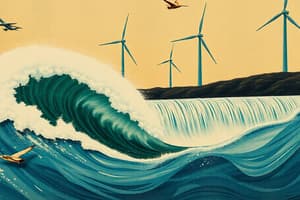Podcast
Questions and Answers
What is the fundamental characteristic that defines a wave?
What is the fundamental characteristic that defines a wave?
- A type of mechanical oscillation
- A disturbance that travels through space and matter (correct)
- A type of electromagnetic radiation
- A type of sound wave
Which type of wave requires a medium to propagate?
Which type of wave requires a medium to propagate?
- Transverse waves
- Mechanical waves (correct)
- Longitudinal waves
- Electromagnetic waves
What is the term for the maximum displacement of a wave from its equilibrium position?
What is the term for the maximum displacement of a wave from its equilibrium position?
- Amplitude (correct)
- Speed
- Frequency
- Wavelength
What is the term for the distance between two successive crests or troughs of a wave?
What is the term for the distance between two successive crests or troughs of a wave?
What is the term for the number of complete oscillations or cycles of a wave per unit time?
What is the term for the number of complete oscillations or cycles of a wave per unit time?
What is the term for the rate at which a wave travels through a medium?
What is the term for the rate at which a wave travels through a medium?
What type of mechanical wave has particles of the medium vibrating perpendicular to the direction of wave propagation?
What type of mechanical wave has particles of the medium vibrating perpendicular to the direction of wave propagation?
What phenomenon occurs when two waves meet in phase, resulting in an increase in amplitude?
What phenomenon occurs when two waves meet in phase, resulting in an increase in amplitude?
What occurs when a wave encounters a boundary?
What occurs when a wave encounters a boundary?
What type of wave is formed by the superposition of two waves with the same frequency and amplitude traveling in opposite directions?
What type of wave is formed by the superposition of two waves with the same frequency and amplitude traveling in opposite directions?
What characterizes standing wave patterns?
What characterizes standing wave patterns?
Flashcards are hidden until you start studying
Study Notes
Definition and Classification of Waves
- A wave is a disturbance or oscillation that travels through space and matter, accompanied by a transfer of energy.
- Waves are classified into two main categories: mechanical waves and electromagnetic waves.
- Mechanical waves require a medium to propagate, such as sound waves and water waves.
- Electromagnetic waves can travel through a vacuum, such as light waves and radio waves.
Properties of Waves
- Amplitude is the maximum displacement of a wave from its equilibrium position.
- Wavelength is the distance between two successive crests or troughs of a wave.
- Frequency is the number of complete oscillations or cycles of a wave per unit time.
- Speed is the rate at which a wave travels through a medium, determined by the medium's properties.
Types of Mechanical Waves
- Transverse waves have particles of the medium vibrating perpendicular to the direction of wave propagation.
- Longitudinal waves have particles of the medium vibrating parallel to the direction of wave propagation.
Wave Interference
- Constructive interference occurs when two waves meet in phase, resulting in an increase in amplitude.
- Destructive interference occurs when two waves meet out of phase, resulting in a decrease in amplitude.
Wave Reflection, Refraction, and Diffraction
- Reflection is the bouncing back of a wave when it encounters a boundary.
- Refraction is the bending of a wave as it passes from one medium to another with different properties.
- Diffraction is the bending of waves around obstacles or through openings.
Standing Waves
- Formed by the superposition of two waves with the same frequency and amplitude traveling in opposite directions.
- Nodes and antinodes characterize standing wave patterns.
Studying That Suits You
Use AI to generate personalized quizzes and flashcards to suit your learning preferences.




